The problem with most box sets is that their price range puts them in a position that only hardcore collectors would buy them, but those same hardcore collectors are likely to own the majority of the contents in their original, separate releases already. Quite the dilemma, and probably why only the most cherished franchises in the world of gaming will see box sets.
Dragon Quest actually has two just for its Symphonic Suites. One decade ago, a box was released for DQ I~VII, these being the London recordings. Now, we have a box set for DQ I~IX, with the Tokyo Metropolitan being the orchestra of choice. Only 5000 copies of the box were made, and Dragon Quest being as popular as it is in Japan, it’s already hard-to-find within months of release.
After the jump, I’ll be talking about the set’s unique “scene-selected” layout, the magic of Sugiyama, his progress and evolution as a composer, and more!
Before gushing, I have to throw one simple critique at this set. It is “scene-selected” the same way as the previous box, in the sense that each game in the series has its music broken into different purposes (within context of the game) and then those purposes, “scenes,” are covered within each disc. But in the seven-disc box set, they took each of the seven recordings of the Overture (which are nearly identical, especially after the intro fanfare) and used that as the introduction to each disc. In this new set, which is actually ten discs (two discs for battle music), the first disc starts with the Overture NINE TIMES IN A ROW. If you do not tailor your listening experience, you will hate the Overture when listening to the first disc. Fortunately, the disc also includes some unique “Prologue” music from the handful of games that use this type of song (II, III, VII, VIII, IX).
Okay, so other than that, this “Scene-Selected” idea is fantastic. As games and as music, Dragon Quest is about as intentionally formulaic as you can get, and yet it still manages to be great. The scene-selected layout allows the listener to see each melody evolve from its first appearance in the series (usually I or II) all the way to its last usage (usually VIII or IX). The scene types are found in the following list:
Disc 1: Beginning of the Adventure (Overture) ~ Prologue
Disc 2: Castle
Disc 3: Town, Village
Disc 4: Field, Character ~ Recollection
Disc 5: Cave, Tower
Disc 6: Requiem, Holy Shrine, Church, Palace ~ Love and Sorrow
Disc 7: Sky, Ocean
Discs 8 and 9: Battle
Disc 10: Ending ~ ME (Music Effect)
Though some people find particular Dragon Quest games to have a favorite or least favorite soundtrack, that has always been a difficult thing for me to discern. With this layout, I instead am able to pick favorite types of music from Sugiyama and see his evolution from 1986 all the way to 2011. Can you guess which discs are my favorite? Can you?
The answers are four and seven.
Disc seven is especially awesome. In both sea and sky travel, you are “floating” in some sense. The levity that comes with this kind of scene is captured so well by Sugiyama, and he nails it so consistently from one game to the next… and yet, these are also the most varied compositions in terms of melody and structure across the series. Thus, I declare disc seven the king of the pack. These songs are so good.
But none of the other discs are without their merit. Seeing the Baroque fugue/invention tracks from disc 2 “Castle” become more or less complex with each game is fantastic. I am especially pleased by DQIX’s “Oboe Melody in the Castle,” which shows that Sugiyama has in no way lost his touch in old age. (Completionists be warned, ownership of this box won’t save you since DQX is just around the corner!).
The field and character themes of disc four are always strong. The original track, “Unknown World” from DQI, remains one of the best pieces of game music, ever. To top it off, while I generally don’t have any preference between the different orchestra recordings, I think the dynamics and the attacks done by the Tokyo Met are noticeably more distinct, and thus “better” (in my mind), than other recordings. The 10 minute “Comrades” medley from DQIV is always delightful, and it contrasts nicely with the field medley (track 11) from DQVIII.
The most difficult disc to discuss in any kind of generalized or cohesive way is the Disc 6 grab bag. It’s like: church-ish stuff, death, romance, emotion. All in one disc. I suppose it’s fair to call this the “slow disc” (like, Largo slow). I don’t know what to make of it, but I will say that it has the power to put me to sleep.
Now then, let’s do a careful track-by-track analysis of Sugiyama’s evolution by using the town/village music of disc three. Here’s the full tracklist of the third disc:
01 – People (I)
02 – Town (II)
03 – Around the World (III)
04 – Rolling Dice (III)
05 – In a Town (IV)
06 – Melody in an Ancient Town ~ Toward the Horizon ~ Casino ~ Lively Town ~ Melody in an Ancient Town (V)
07 – Sad Village ~ Mysterious Disappearance ~ Disturbed Village (V)
08 – In the Town ~ Happy Humming ~ Inviting Village ~ Folk Dance ~ In the Town (VI)
09 – Strolling in the Town (VII)
10 – Heavenly Village (VII)
11 – Peaceful Town ~ Quiet Village ~ Alchemy pot (VIII)
12 – Chatting (VIII)
13 – Beckoning ~ Dream Vision of our Town ~ Tavern Polka ~ Beckoning (IX)
14 – Village Bathed in Light ~ Village in Darkness (IX)
“People” follows a simple chord progression, and goes back and forth between legato and staccato melodic patterns. It is simple and effective. DQII’s “Town” follows a similar legato-then-staccato pattern, but with longer segments of each, and the B section being taken by the brass instead of the strings (II was always a more brassy, jazzy soundtrack than its peers). DQIII’s “Around the World” opens with a light-hearted, spirited melody reminiscent of the previous two. Its opening is staccato, with the legato section coming later. The orchestra bells are especially effective in the A section. But then, “Around the World” is a medley track, so we get the fantastic Jipangu (Asian/Japanese) music next as an entirely new “formula” to add to Sugiyama’s repertoire. Even this track has a familiar B-section though, reminiscent of previous town themes in its straightforward down-up down-up backing. DQIII also introduces casinos, so we get “Rolling Dice” as a separate track.
DQIV’s “In a Town” medley has the typical town melody from I and II, a darker/ethnic track similar to III’s Jipangu, and more. At 8 minutes, it’s solid and takes you through a wonderful set of music, all moderate-tempo. Things come to a head with the content-rich music of Dragon Quest V. Foregoing character themes altogether, DQV has a bevy of different town themes, broken into two separate medleys. The first of these themes is the typical spirited Town theme established since the first game… from there, we get the more thoughtful (and slightly faster) “Toward the Horizon” (really fits Field better than Town), then the Casino music (which sounds akin to DQIII’s “Rolling Dice”), and a reprise of the Town music. Then there’s the “Sad Village ~ Mysterious Disappearance ~ Disturbed Village” as a separate medley. Sad Village takes “Melody in an Ancient Town,” slows it down, and puts some somber tones in (albeit sparingly). Disappearance is scary, but then “Disturbed Village” doesn’t fit its name too well. There are moments of tension and sorrow, but is still fairly positive.
DQVI has a 7 minute town medley. You can write this paragraph for me, right? Well, not exactly. The first sentence would be easy: “In the Town plays off the old town theme from all previous DQs.” Alright, good. Happy Humming is a little more of the same. But later in the medley we get some very catchy melodies that hadn’t surfaced before. I see DQVI as a time of the series’ maturing (perhaps into something fans won’t always like, but a maturing nonetheless). “Inviting Village” and “Folk Dance” have more varied melody, syncopation, and decoration than almost all the previous tracks.
DQVII presents us with an 8 minute medley, followed by a solitary piece “Heavenly Village” (2.5 minutes in length). The latter is one of DQVII’s best songs and again shows the maturity and nuance in Sugiyama’s themes. The traditional Western European classical/romantic soundscape remains, but now Sugiyama is willing to explore more tonal structures, something closer to Hisaishi than Brahms. Not that there’s anything wrong with Brahms (I love the man, I do!).
The DQVIII town medley (track 11) takes nuance to a level where melodies are too easy to forget. However, the extra track “Chatting” is a highlight for the disc. This uplifting, bouncy little tune makes great use of pitched percussion (xylophone etc) and the swelling of strings under the super-high-pitched melody. Things “end” with DQIX’s tracks, which are not the best, but fortunately, this will not be the last game in the series.
The progression we see in disc three is similar throughout the rest of the album. The simple, unforgettable baseline of the first game is elaborated upon, enhanced, and then new melodies are added, and only rarely is the original pattern fully dropped. Things seem to reach a peak in V and VI, but that isn’t to say that Sugiyama doesn’t have great compositions in VIII and IX. That, indeed, varies from disc to disc. Complexity comes with each successive game.
And thus, with each disc (other than the first and last), the push from simple and memorable to elaborated and studied comes slowly at first, but then with such force that only the attentive listener will still be enjoying it by the end. And, I hope, if you’re serious enough to buy this box, you’ll be an attentive listener.
Tags: Box, Box Sets, Compilations, DQ, Dragon Quest, King Records, Koichi Sugiyama, Music Reviews, Ocean, Reviews, Scenes, Sea, Sky, Square Enix, Sugilabel





























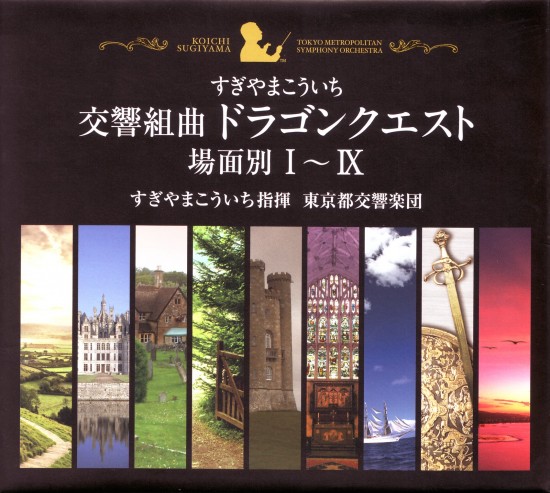
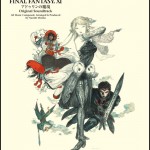
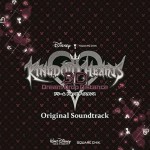
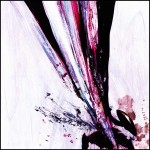
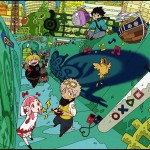







I’m Really glad that Koichi Sugiyama released a symphonic suite box ste recording witch includes the music from DQ 9 I wish I had a download Zip file link for this so I Could put it on Media fire or something like that anyway this so cool I love this and I love Koichi Sugiyama I Happened to be supporting him for a concert called Video games Live his music will be performed on Piano this year thanks to Tommy Tallarico woo I Love you Koichi Sugiyama